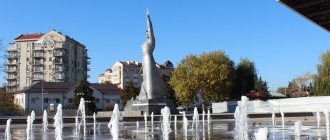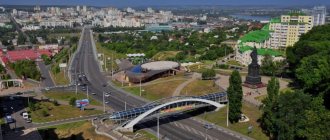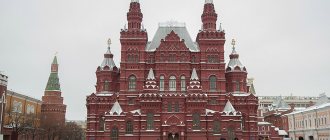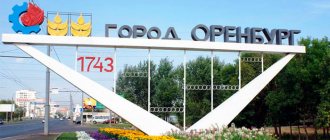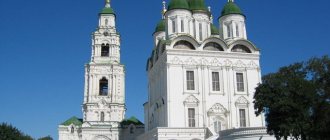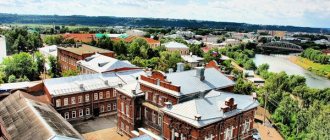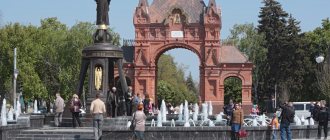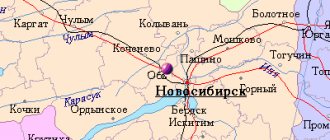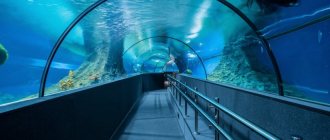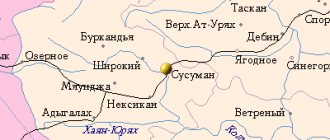The Krasnodar Territory is one of the three most densely populated regions of the country with an indicator of 5,647,652 people. And if we consider that the first two positions are occupied by St. Petersburg and Moscow, it can be called the largest region of Russia. At the same time, the All-Russian granary and the main destination for beach holidays cannot boast of a large area. The size of the territory is only 75,485 km², which puts the region in 41st place in the national ranking between the Nizhny Novgorod region and the Republic of Kalmykia. Because of this, there is a high level of density - 74.81 people/km²: eighth place among all subjects of the Russian Federation.
Content
- 1 Millionaire cities with more than 1 million people 1.1 Krasnodar
- 2.1 Sochi
- 3.1 Armavir
- 4.1 Abinsk
Kuban (region)
Kuban (region) Krasnodar region
| Flag of Krasnodar region | Coat of arms of the Krasnodar region |
Administrative centerKrasnodarSquare
5,141,852 people (2009) 68.1 people/km²
— Total, at current prices — Per capita
RUB 465.9 billion (2006) 91.4 thousand rubles.
Federal DistrictSouthernEconomic regionNorth CaucasianHead of AdministrationAlexander Nikolaevich TkachevFirst Vice GovernorDzhambulat Khizirovich KhatuovChairman of the Legislative AssemblyVladimir Andreevich BeketovHymnAnthem of the Krasnodar regionVehicle code23, 93TimezoneMSK (UTC+3, summer UTC+4)The administrative center is the city of Krasnodar.
The head of the administration (governor) of the region is Alexander Nikolaevich Tkachev.
Large cities 250-500 thousand people
Coat of arms of Sochi
Sochi
Population 443,562 (2020), founded in 1838. One of the most important resort cities in the country. It is located in a subtropical climate zone on the Black Sea coast, but, in addition, it also includes ski resorts, since it is located in a mountainous area. The peculiarity of the city is its very large extent and the fact that it actually consists of separate settlements in neighboring valleys.
The city hosted the 2014 Winter Olympics, in preparation for which the city became an important sports center in the country.
The most important transport infrastructure facilities:
- Sochi seaport.
- Port Imeritinsky.
- Combined railway and highway Adler - Alpika-Service.
The most important sports infrastructure facilities:
- Fisht Stadium
- Ski resort "Rosa Khutor"
Novorossiysk
Coat of arms of Novorossiysk
The population within the boundaries of the urban district with its rural settlements is 325,304 people as of 2016, the city itself is 266,977 people (2016). Hero City since September 14, 1973.
Founded in 1838, city since 1866. Located in the southwest of the region, on the coast of Tsemes Bay of the Black Sea.
The most important transport center. The city has the largest port of Russia and the Black Sea, including passenger, cargo ports and an oil harbor. The terminus of the railway line from Krasnodar, a highway junction. The city is the largest center of the cement industry in the south of Russia - five cement factories operate there using local raw materials. The city is also home to a famous winery.
The city is home to a large naval base of the Russian Black Sea Fleet, which was radically reconstructed in the 2010s.
Armavir is large and economically significant
The second place in the largest settlements in the Krasnodar Territory is occupied by Armavir - 280 km². The founding date is considered to be 1839, when the Circassian Gai, also known as the Circassian Armenians, founded a settlement near the Urup River, a tributary of the Kuban. This happened due to the fact that Islam began to spread in the northern Caucasus, and the people adhered to the Orthodox faith, belonging to the Apostolic Church of Armenia.
Since its inception, the village has been quite large by the standards of the region - 120 families, which increased to four hundred within a year. Thanks to its partnership with the Russian state and its location on its territory, the village was not damaged during the Caucasian War. Minor unrest found him after the revolution: power changed three times, however, as elsewhere, it soon became entrenched in the hands of the “reds.”
Today it is one of the largest economic centers in the region, where there are about 35 significant manufacturing enterprises involved in such areas as:
- defense engineering;
- food industry;
- metal processing;
- electric power industry;
- mechanical engineering;
- production of building materials;
- non-ferrous metallurgy and others.
Armavir is also one of the leading suppliers of bakery products in the region: 80 bakeries sell products throughout the North Caucasus. Public transport is well developed, and its close location to Krasnodar and the Kavminvod resorts makes it an important logistics hub. It is also interesting from a tourist point of view: more than 350 attractions, including monuments of prehistoric eras, buildings of the 19th century and remarkable modern art objects.
Medium-sized cities 20-100 thousand people
Abinsk
Population 37,415 people (2016).
Anapa
Population 73,410 people (2016). Resort city on the Black Sea. Specializes in children's recreation.
Apsheronsk
Population 40,349 people (2016).
Belorechensk
Population 52,153 people (2016).
Gelendzhik
Population 72,030 people (2016). Resort city on the Black Sea.
Hot key
Population 35,805 people (2016). Resort town on thermal mineral waters.
Gulkevichi
Population 34,289 people (2016).
Yeysk
Population 85,192 people (2016). A port on the Sea of Azov, a resort town with beaches and healing mud, popular for windsurfing. The city is home to an extra-curricular joint airfield (military and civilian), on the basis of which the most important military training center for naval aviation is located, which also includes one of the two NITKA simulators available in the country for training carrier-based aircraft carriers.
Korenovsk
Population 41,876 people (2016).
Kropotkin
Population 79,664 people (2016).
Krymsk
Population 57,184 people (2016).
Kurganinsk
Population 49,006 people (2016).
Labinsk
Population 60,665 people (2016).
Novokubansk
Population 35,440 people (2016).
Primorsko-Akhtarsk
Population 31,987 people (2016).
Slavyansk-on-Kuban
Population 65,812 people (2016).
Temryuk
Population 39,646 people (2016). The largest settlement on the Taman Peninsula. Seaport on the Sea of Azov. Known for its mud volcanoes.
Timashevsk
Population 52,581 people (2016).
Tikhoretsk
Population 59,297 people (2016).
Tuapse
Population 63,058 people (2016). Large port on the Black Sea.
Ust-Labinsk
Population 41,729 people (2016).
Khadyzhensk
Population 22,733 people (2016). Resort on mineral waters.
Areas located in the mountains
In addition to a beach holiday, lovers of mountain hiking will also find a lot of interesting things to do in the Krasnodar Territory.
Any time of year is suitable for visiting mountainous areas. In winter, ski resorts begin to operate. The region has a good infrastructure for skiing: slopes are equipped, lifts are installed, equipment rental is organized, and special bases are built. You can choose a slope that suits your skill level. Hotels have been built for accommodation. In other periods, mountainous areas await hikers. In summer, mountaineering routes and mountain rafting are open here for extreme sports enthusiasts. Hiking and horseback riding routes are also available for those who prefer a quiet, contemplative holiday. It is worth mentioning the wonderful hunting and fishing in these places. A visit to the mountains will give you an experience of a lifetime!
Climbers should pay attention to the Otradnensky district. Here is the Drum Rock, which is very suitable for training climbs. For those who like simple mountain hikes, we can recommend the mountains of the Seversky region. The local trails are quite steep and climbing will require some effort, but this is still not mountaineering. From the top, by the way, there is a beautiful view of the surrounding area.
see also
- Krasnodar region
- Cities of Russia
| [ + ] Cities by regions of Russia | |
| Cities of the North-West (NWFD) | St. Petersburg (and its cities) • Leningrad region (historical Staraya Ladoga) • Arkhangelsk region • Vologda region • Kaliningrad region • Karelia • Komi • Murmansk region • Nenets Autonomous Okrug • Pskov region |
| Cities of the Volga region (Volga Federal District) | Bashkortostan • Volgograd region • Kalmykia • Kirov region • Mari El • Mordovia • Nizhny Novgorod region • Orenburg region • Penza region • Perm region • Samara region • Saratov region • Tatarstan • Udmurtia • Ulyanovsk region • Chuvashia |
| Cities of Southern Russia (SFD) | Sevastopol (including Inkerman) • Republic of Crimea • Adygea • Astrakhan region • Krasnodar region • Rostov region |
| Cities of the North Caucasus (NCFD) | Dagestan • Ingushetia • Kabardino-Balkaria • Karachay-Cherkessia • North Ossetia - Alania • Stavropol Territory • Chechen Republic |
| Cities of the Urals (Ural Federal District) | Kurgan region • Sverdlovsk region • Tyumen region • Khanty-Mansi Autonomous Okrug - Yugra • Chelyabinsk region • Yamalo-Nenets Autonomous Okrug |
| Cities of Siberia (Siberian Federal District) | Altai Republic • Altai Territory • Irkutsk Region • Kemerovo Region • Krasnoyarsk Region • Novgorod Region • Novosibirsk Region • Omsk Region • Tomsk Region • Tyva • Khakassia |
| Cities of the Far East (FEFD) | Amur Region • Buryatia • Jewish Autonomous Region • Trans-Baikal Territory • Kamchatka Territory • Magadan Region • Primorsky Territory • Sakha (Yakutia) • Sakhalin Region • Khabarovsk Territory • Chukotka Autonomous Region |
| see also | Cities of the DPR, LPR, Transnistria, South Ossetia • Regions of Russia • Cities of Russia |
Administrative-territorial division of the Krasnodar Territory
In accordance with the Law of the Krasnodar Territory of July 2, 2009 No. 1765-KZ “On the administrative-territorial structure of the Krasnodar Territory and the procedure for changing it” [1], cities of regional subordination were excluded from the objects of administrative division. The objects of the administrative-territorial division of the Krasnodar Territory are:
The same law declared the Law of the Krasnodar Territory of October 6, 2004 No. 780-KZ “On the administrative-territorial structure of the Krasnodar Territory and the procedure for its amendment” as no longer in force.
The Krasnodar Territory includes:
[2]
(data are provided based on information from the Register of Administrative-Territorial Units of the Krasnodar Territory and the Law of the Krasnodar Territory dated June 3, 2009 No. 1756-KZ).
What to bring
If we discard the magnetic shell nonsense that is packed to capacity in the counters of every resort town in the Krasnodar Territory, then there is a chance to fill the resulting emptiness in the suitcases with really worthwhile souvenirs.
Tasty and healthy: herbal infusions and teas from the slopes of the Caucasus mountains, aromatic spices and hot sauces, churchkhela, marshmallows, nuts, fresh and dried fruits and berries. In winter, a jar of dogwood jam, chestnut honey or a bunch of dried persimmons will be an excellent reminder of the holiday.
In the subtropics of Sochi, it’s worth buying a good broom of laurel - every housewife will be glad to have a sprig of such a souvenir, the local laurel is much more fragrant than its dull counterparts from the average grocery department.
The day before leaving the seaside resort, take a walk to the market for dried, smoked or salted fish. Another important item in the souvenir program is the heady Kuban, Taman and Abkhazian wines. Almost every town will have its own “best” wine or tincture, but it’s better to buy it in specialized stores so as not to take home colored water with the aroma of alcohol. An amateur winemaker will be grateful for a small oak barrel to infuse his product. Such souvenirs are traded in Tuapse.
From useful, but inedible items, we add crafts made from juniper to the shopping list - spoons, bowls, coasters, massage items, pillows with shavings. All this serves reliably and gives a wonderful aroma for a long time. From areas with a sanatorium bias, we bring healing clays, mineral salts and cosmetics based on them. Northerners will find warm mittens and socks made of natural goat wool useful; they are actively traded in the Sochi and Adler areas.
Rent a Car
A rented car will be a great help on wild trips along the Black Sea coast; the local region is distinguished by thoughtful natural beauty, for which it is worth breaking away from standard tourist routes. In addition, by car it is much easier to find a cozy and secluded small beach for an overnight stay or contemplative rest.
Don’t forget that mountain roads with serpentines, sharp turns and passes stretch along the sea; this is not a place for beginners.
The rental business in the region is well developed; many large international companies provide their services. Of the regional companies, AutoHolding, which operates in Krasnodar, Sochi and Anapa, the Krasnodar-based Rental Auto 93 with representative offices in Anapa, Gelendzhik, Tuapse and Novorossiysk, as well as Yug-Avtoprokat, offering cars in the regional center and Novorossiysk, attract attention. In Krasnodar, you can still inquire about the conditions and the fleet, which consists of cars of the maximum configuration.
Prices are standard for Russian regions. Budget cars and economy class start from 900-1500 RUB per day, middle class - 1500-2550 RUB, for crossovers and SUVs they ask from 2300 RUB, for increased comfort of the Volvo S60 or Nissan Teana level for short-term rental you will have to pay about 3800 RUB per day.
